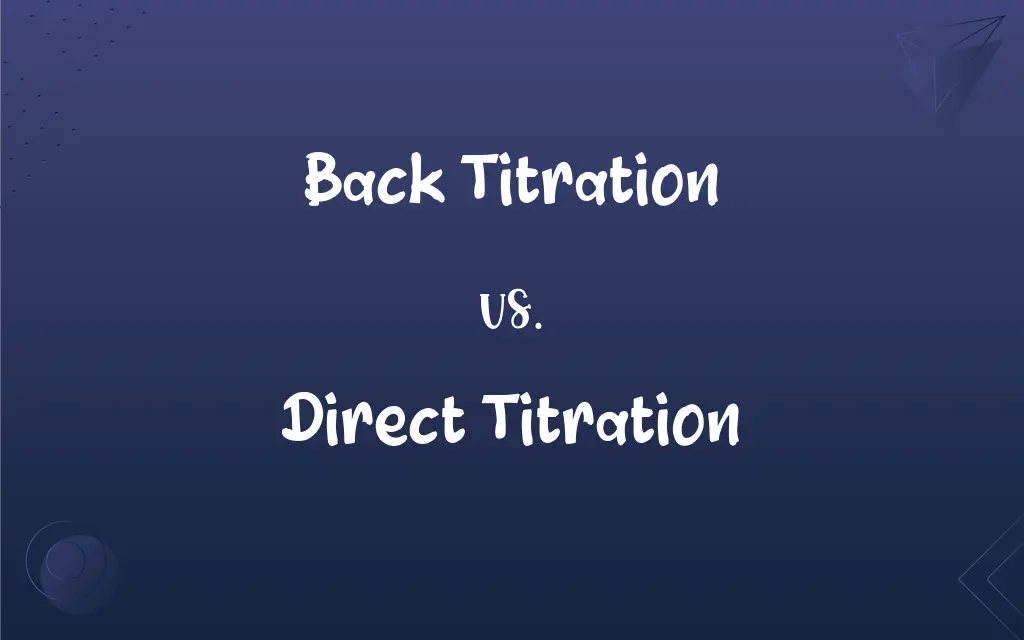Back Titration vs. Direct Titration: What's the Difference?
Edited by Aimie Carlson || By Harlon Moss || Published on January 31, 2024
Back titration involves adding an excess of a standard solution to a sample, then titrating the excess; direct titration measures the amount of a titrant required to react completely with a sample analyte.

Key Differences
In back titration, an excess known amount of a reagent is added to the analyte, then the remaining reagent is titrated. Direct titration involves adding a titrant directly to the analyte until the reaction reaches completion.
Back titration is used when the analyte is volatile, insoluble, or reacts slowly. Direct titration is applied to reactions that are quick and complete, where the endpoint is easily observable.
The endpoint in back titration is determined by titrating the excess reagent. In direct titration, the endpoint corresponds directly to the reaction of the titrant with the analyte.
Back titration can be less precise due to the two-step process but is necessary for certain conditions. Direct titration tends to be more straightforward and precise for suitable reactions.
Back titration may be more time-consuming due to the additional steps involved. Direct titration is generally quicker and more efficient for reactions that are suitable for this method.
ADVERTISEMENT
Comparison Chart
Methodology
Excess reagent added, then excess is titrated
Titrant added directly to analyte until completion
Applications
Used for volatile, insoluble, or slow-reacting analytes
Suitable for quick, complete reactions with clear endpoints
Endpoint Determination
Endpoint is found by titrating the excess reagent
Endpoint corresponds to the completion of the reaction
Accuracy
Potentially less precise due to two-step process
Generally more precise for suitable reactions
Efficiency
More time-consuming with additional steps
Quicker and more efficient for appropriate reactions
ADVERTISEMENT
Back Titration and Direct Titration Definitions
Back Titration
It’s used when direct titration is not suitable.
Back titration is applied to quantify antacids in tablets that are not soluble.
Direct Titration
Direct titration involves adding a titrant to an analyte until the reaction is complete.
Acid-base titrations, like titrating NaOH with HCl, are common examples of direct titration.
Back Titration
Back titration is a method where an excess of standard reagent is added, then the excess is titrated.
In determining calcium content in limestone, back titration is used after reacting it with excess HCl.
Direct Titration
Commonly used with color indicators to signal endpoint.
Phenolphthalein is often used as an indicator in acid-base direct titrations.
Back Titration
It can be more time-consuming than direct titration.
The process of back titrating an impure sample of a base may take longer than direct methods.
Direct Titration
Suitable for reactions with fast and clear endpoints.
Determining the concentration of vitamin C using direct titration with iodine.
Back Titration
Useful for slow-reacting or insoluble analytes.
Back titration is used for substances that react too slowly for direct titration.
Direct Titration
It’s ideal for solutions that are stable and react completely.
Direct titration is employed in redox reactions like titrating iron(II) ions with potassium permanganate.
Back Titration
Involves two titrations: initial and back titration.
To analyze aspirin, back titration involves first reacting with NaOH, then titrating with HCl.
Direct Titration
Typically more straightforward and quicker.
Direct titration is used in water hardness analysis for its speed and simplicity.
FAQs
What is direct titration?
Direct titration is a method where a titrant is added directly to an analyte until the reaction reaches its endpoint.
Can back titration handle multiple analytes?
Yes, it can be used to analyze multiple components in a mixture.
What is back titration?
Back titration is a technique where an excess amount of a known reagent is added to the analyte, followed by titration of the excess.
Is back titration more time-consuming?
Yes, it generally takes more time due to the two-step process.
How is the endpoint determined in back titration?
It's determined by titrating the excess reagent with another titrant.
What types of reactions are suitable for direct titration?
Reactions that are quick, complete, and have a clear endpoint are suitable.
When is back titration preferred?
It’s preferred for insoluble, volatile, or slow-reacting analytes.
How accurate is direct titration?
It’s very accurate for suitable reactions with well-defined endpoints.
What is a primary standard in direct titration?
A primary standard is a highly pure, stable compound used to calibrate titrants in direct titration.
Is direct titration suitable for volatile substances?
It's less suitable for volatile substances due to potential losses during the process.
What equipment is needed for back titration?
Standard laboratory titration equipment, including burettes, flasks, and indicators, is required.
What indicators are used in direct titration?
Common indicators include phenolphthalein, bromothymol blue, and methyl orange.
Are there any safety concerns with back titration?
Standard laboratory safety practices should be followed, especially when handling strong acids or bases.
How does back titration differ from a standard titration?
It involves an initial reaction followed by titration of the remaining excess reagent, unlike standard titration where the titrant is added directly to the analyte.
Can direct titration be used for weak acids or bases?
Yes, it’s suitable for weak acids or bases, with appropriate choice of indicators.
How do you choose an indicator for direct titration?
The indicator is chosen based on the pH change at the endpoint of the titration.
Can direct titration be automated?
Yes, direct titration can be automated for efficiency and precision.
Why might back titration yield less precise results?
Due to the two-step process and potential for compound instability or side reactions.
What are some common applications of direct titration?
It’s widely used in water hardness testing, acid-base titrations in chemistry, and pharmaceutical analysis.
What is the role of the titrant in back titration?
The titrant in back titration is used to quantify the excess reagent after the initial reaction.
About Author
Written by
Harlon MossHarlon is a seasoned quality moderator and accomplished content writer for Difference Wiki. An alumnus of the prestigious University of California, he earned his degree in Computer Science. Leveraging his academic background, Harlon brings a meticulous and informed perspective to his work, ensuring content accuracy and excellence.
Edited by
Aimie CarlsonAimie Carlson, holding a master's degree in English literature, is a fervent English language enthusiast. She lends her writing talents to Difference Wiki, a prominent website that specializes in comparisons, offering readers insightful analyses that both captivate and inform.







































































